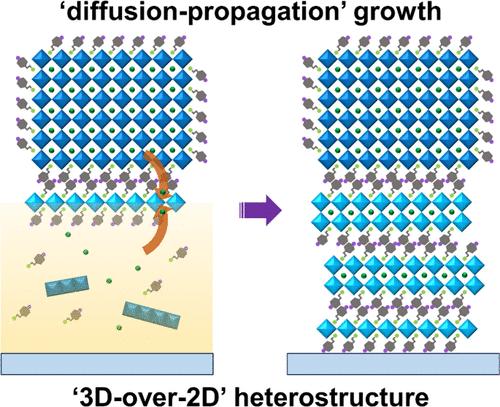Unraveling the Formation Mechanisms of Highly Oriented Tin Perovskite with a 3D-over-2D Heterostructure
IF 18.2
1区 材料科学
Q1 CHEMISTRY, PHYSICAL
引用次数: 0
Abstract
Tin-based perovskites (TinPVKs) have become the most promising candidates for lead-free perovskite solar cells, owing to its low toxicity and improved photovoltaic performance. However, due to the absence of 4f shell, TinPVKs suffer from uncontrolled crystallization, limiting the power conversion efficiency (PCE) of tin perovskite solar cells (TinPSCs). Here, we systematically study the ligand regulated crystallization process of TinPVK. We find that with elongated spin time, TinPVK crystals undergo reorientation and lateral growth. 3D α-phase FASnI3 and 2D (n = 2) and 2D (n = 1) phases emerge sequentially to form a “3D-over-2D” heterostructure via a proposed “diffusion-propagation” mechanism. TinPSCs exhibit improved open circuit voltage (VOC) due to favorable energy level alignment of the 3D-over-2D heterostructure, with a champion PCE value of 13.07% and T80 value of over 1200 h. This work provides mechanistic insights on controlled crystallization and heterostructure formation of TinPVKs, paving the way toward high-efficiency TinPSCs.

揭示具有 3D-over-2D 异质结构的高取向锡包晶的形成机理
锡基包晶石(TinPVKs)因其低毒性和更好的光电性能,已成为无铅包晶石太阳能电池最有前途的候选材料。然而,由于缺乏 4f 壳,TinPVKs 存在结晶失控的问题,从而限制了锡包晶体太阳能电池(TinPSCs)的功率转换效率(PCE)。在此,我们系统地研究了配体调控 TinPVK 的结晶过程。我们发现,随着旋转时间的延长,TinPVK 晶体会发生重新定向和横向生长。三维α相FASnI3和二维(n = 2)及二维(n = 1)相依次出现,通过一种拟议的 "扩散-传播 "机制形成 "三维-二维 "异质结构。由于 3D-over-2D 异质结构的能级排列良好,TinPSC 显示出更高的开路电压(VOC),冠军 PCE 值为 13.07%,T80 值超过 1200 h。这项工作提供了关于 TinPVK 受控结晶和异质结构形成的机理见解,为实现高效 TinPSC 铺平了道路。
本文章由计算机程序翻译,如有差异,请以英文原文为准。
求助全文
约1分钟内获得全文
求助全文
来源期刊

ACS Energy Letters
Energy-Renewable Energy, Sustainability and the Environment
CiteScore
31.20
自引率
5.00%
发文量
469
审稿时长
1 months
期刊介绍:
ACS Energy Letters is a monthly journal that publishes papers reporting new scientific advances in energy research. The journal focuses on topics that are of interest to scientists working in the fundamental and applied sciences. Rapid publication is a central criterion for acceptance, and the journal is known for its quick publication times, with an average of 4-6 weeks from submission to web publication in As Soon As Publishable format.
ACS Energy Letters is ranked as the number one journal in the Web of Science Electrochemistry category. It also ranks within the top 10 journals for Physical Chemistry, Energy & Fuels, and Nanoscience & Nanotechnology.
The journal offers several types of articles, including Letters, Energy Express, Perspectives, Reviews, Editorials, Viewpoints and Energy Focus. Additionally, authors have the option to submit videos that summarize or support the information presented in a Perspective or Review article, which can be highlighted on the journal's website. ACS Energy Letters is abstracted and indexed in Chemical Abstracts Service/SciFinder, EBSCO-summon, PubMed, Web of Science, Scopus and Portico.
 求助内容:
求助内容: 应助结果提醒方式:
应助结果提醒方式:


